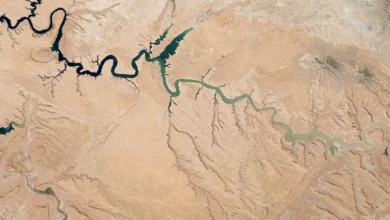
Lead Image: UC Berkeley entomologist Kipling Will discovered a specimen of Bembidion brownorum while sampling for insects near Freshwater Creek on former Gov. Jerry Brown’s ranch. The species had not been observed by scientists in more than 55 years. Credit: David Maddison
During the insect sampling expedition at Jerry Brown’s ranch, a researcher from UC Berkeley stumbled upon a beetle species that had eluded scientific observation since 1966.
Upon learning that ex-Governor Jerry Brown was inviting field researchers to his Colusa County ranch, Kipling Will, a University of California, Berkeley entomologist, was eager to seize the opportunity to search for beetles on the estate.
“I reached out and said, ‘Hey, I want to sample your beetles,’” Will said. “And [Brown] was quite game to let me come up there.”
Being a professor in environmental science, policy, and management, Will has ventured all across California to examine carabid beetles. These ground beetles play a critical role as predators of other insects in agricultural and garden ecosystems. However, his recurrent explorations at Brown’s ranch turned out to be particularly rewarding.
While sampling for insects near Freshwater Creek, Will collected a rare species of beetle that had never been named or described — and which, according to records, had not been observed by scientists in over 55 years. The new species will be named Bembidion brownorum, in honor of Brown and his wife, Anne Brown.
“I’m very glad that [my ranch] is advancing science in some interesting and important ways,” said Brown, who has hosted a wild variety of field researchers, including geologists, anthropologists, and botanists, on the property. “There are so many undiscovered species. I think it’s very important that we catalog and discover what we have and understand their impact on the environment — how it’s functioning and how it’s changing.”
Brown’s 2,500-acre ranch is about an hour’s drive north of Sacramento, in an agricultural region where most of the land is privately owned and insect biodiversity is historically understudied. For more than two years, Will has regularly sampled for insects on the ranch, sometimes even showing the beetles that he finds to the Browns.

Jerry Brown said his dedication to welcoming researchers onto his land is rooted in the ranch’s history as a stagecoach stop called Mountain House, and in his own interest in climate change and conservation.
“We don’t have stagecoach stop, but we have a place of gathering, of research and collaboration,” said Brown, who is currently chair of the California-China Climate Institute at UC Berkeley.
After collecting a beetle at the ranch that didn’t resemble any species he was familiar with, Will called up Bembidion expert David Maddison, a professor of integrative biology at Oregon State University, to help identify the specimen. Together, the scientists used morphological and DNA analysis to confirm that the beetle represented a completely new species.
Will then combed through entomology collections at museums throughout California in search of other specimens that may have been unlabeled or misidentified. He found only 21 other specimens of the species, the most recent of which was collected in 1966.
The lack of any more recent specimens indicated to him that the species likely collapsed during the second half of the 20th century, driven out of its natural habitat by rapid urbanization and agricultural development across the state.
“The sad truth is, [the species] has probably been in a huge decline. If you look at the places that it was found in the ‘20s and ‘30s and ‘40s, almost none of that natural habitat is left,” Will said. “But we don’t know for sure. So, the thing to do is to get it out there, describe it, and tell people, ‘Hey, look for this thing,’ because maybe we’ll find someplace where it’s doing fine.
“Having access to Jerry’s ranch in Colusa County gives me the opportunity to really spend time sampling, to look for rare things like this.”
Will and Maddison describe Bembidion brownorum in a study recently published in the journal Zookeys.
Big for a Bembidion
To the naked eye, Bembidion brownorum isn’t particularly remarkable: The diminutive beetle is brown in color and measures around 5 millimeters in length, about the diameter of a standard pencil. But under magnification, it glows with a green and gold metallic shimmer.
It was the unusual shape of the beetle’s prothorax, the segment of the insect that sits right behind its head, that first caught Will’s eye.
“I was looking at this one beetle thinking, ‘It just doesn’t fit any of the ones that I can identify,’” Will said. “The shape of the prothorax is just not like any of the others.”
According to Maddison, Bembidion brownorum is also relatively large compared to other Bembidion beetles, which are usually closer to 3 to 4 millimeters in length.
“It’s big for a Bembidion,” Maddison said. “At first glance, it was pretty obvious that it was probably something new.”

With so few examples to study, it’s difficult to describe the lifestyle and behavior of Bembidion brownorum with any certainty, Will said. However, given where the beetle was found on Brown’s ranch — in the vicinity of Freshwater Creek, which occasionally dries into a series of trellis-like pools in the summer months — it is likely that the beetle lives near the edges of bodies of water that periodically flood and then evaporate.
The 21 historical specimens of Bembidion brownorum are housed at either the Essig Museum Entomology Collection at UC Berkeley or at the California Academy of Sciences in San Francisco, which both have insect specimens going back more than 100 years. The discovery highlights the vital importance of maintaining these collections for current and future research, the scientists said.
“One of the things that I find interesting about is that, before Kip found that specimen, there were already specimens in collections — there was this hidden diversity that people didn’t recognize,” Maddison said. “At one point, [the beetle] probably was much more widespread and much more common, and Kip and I have some ideas as to where you would target to try to find more.”
Previous specimens were collected at locations throughout the Central Valley and in the Los Angeles Basin, regions that have been transformed over the last century. While the beetle may still survive in some areas, Will said that the patchwork of private landownership may make it difficult to find.
“There is a lot of desire to conserve the environment and combat climate change, but in many cases, we’re not keeping up with the rate of extinction — we’re not able to describe the species that need to be described as fast as things are going extinct,” Will said. “And this certainly is true in California, where there are an awful lot of undescribed insects out there and not a lot being done to get them described. I think that having more knowledge of what they are and where they live is really fundamental.”
Reference: “Re-collected after 55 years: a new species of Bembidion (Coleoptera, Carabidae) from California” by David R. Maddison, John S. Sproul and Kipling Will, 27 March 2023, ZooKeys.
DOI: 10.3897/zookeys.1156.101072
John S. Sproul of the University of Nebraska Omaha is also a co-author of the study. The research was funded by the Harold E. and Leona M. Rice Endowment Fund at Oregon State University.



